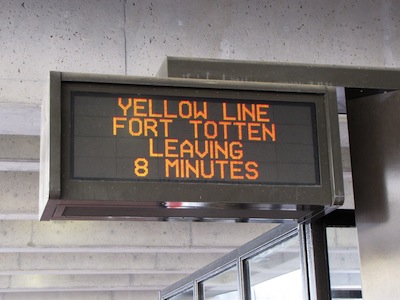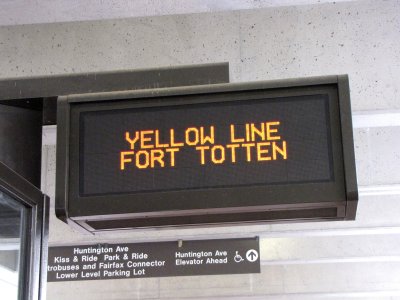“Where is this train going?” takes on new significance with Rush+…
5 minute read
December 18, 2012, 9:37 AM
So in reading the Express this morning, I looked at Dr. Gridlock’s column on the DC Rider page. There were three questions: two about escalators, and one about destination signs at Franconia-Springfield.
I took issue with the answer to that third question, which went as such:
Q: I am a regular rider at Franconia-Springfield and am adjusting to most parts of Rush Plus. However, the problem remains that trains pull into the station, turn off their destination signs, and you are left to guess whether it’s a Blue or Yellow Line train until about 30-45 seconds before they close the doors. It’s particularly frustrating when it is cold outside and there are two trains waiting with their doors open. Is there any way to persuade Metro to leave the direction signs lit?
A: I don’t see a good reason a train operator would need to turn off the destination signs, unless just maybe Metro isn’t sure where to send the train till the last minute. What I’m thinking of here is that the operations center monitors the crowding on the platforms and could alter a train’s route – though unlikely.
The problem with this answer is that it looks at things from a far higher level than it ought to. The train’s destination sign is controlled from the lead car of the train, where the operator is. While there may be some on-the-fly decisions coming from Central Control about whether to send a given train out of Franconia-Springfield as a Blue Line or a Yellow Line train, in most cases, this likely is not the case.
Basically, the signs only function when the train is “turned on” (not a technical term) with a key on the cab control panel. If you watch when the trains arrive at a terminal station, the destination signs go dark right after the doors open. This is caused when the operator turns the train off. If the door message is playing when the train is turned off, this will cut that off as well. The interior LED signs also go dark for the same reason. All of this is quickly followed by the train operator’s opening the cab door and leaving the train. If you watch carefully when the train is about to leave, the process happens in reverse. Operator enters the cab, the signs come on, and then the doors close. You may also notice that when there is an operator change in the middle of the line, the destination signs go blank for a few moments before coming back on. This happens when one operator takes their key out and the other puts their key in. That time while the keys are being changed makes the signs go blank.
Bottom line: no key, no signs.
This has only really become an issue recently, however, because of Rush+ service. Prior to Rush+, no terminal station originated more than one service. The only trains that ever originated from Franconia-Springfield were Blue Line trains. Now there are also Yellow Line trains that start there. And I will agree that this is a very legitimate concern. Blue and Yellow Line trains diverge at Pentagon station and end up in very different places. Getting the wrong train could incur a significant time penalty due to the need to change trains and backtrack if one got on the wrong train.
So the question becomes, knowing the technical reason for blank signs, what is a good solution to this problem?
Let’s first eliminate a couple of potential solutions that would seem plausible but aren’t viable for whatever reason. The first of these is keying the train on, setting the sign, and then leaving it to idle with the keys in until it’s time to go. While that might seem reasonable at first glance, I would dismiss it out of hand for safety reasons. Specifically, you don’t want to leave the keys to a Metro train unattended, even in a closed cab. First, the cab door does not exactly have “Fort Knox-style” security. I’d imagine that one could kick it in without too much effort, though I would strongly recommend not trying this in real life. Additionally, the bulkhead door on the front of the train is, to my knowledge, never locked. In either case, it’s the same idea behind why you don’t leave the keys in your personal vehicle while it’s unattended: anyone could come in and take the vehicle for a joyride. And I think it’s safe to say that Metro has enough problems on its hands without the risk of someone getting their hands on the keys to the rail car either to cause deliberate harm, or because they have always wanted to drive one of these things because it looks like fun, and oh, look, the key is already there. Don’t laugh about the latter – something similar has happened before in New York City.
Now the second instance of plausible-but-not-viable would be to go in, turn the train on, set the signs, and then turn the train back off until it’s time to go. This would have worked twelve years ago when the 4000-Series was the newest order of cars, but it won’t work anymore. Before the introduction of the 5000-Series, Metro’s entire rail fleet was fitted with “flip dot” signs, i.e. these. Those signs will hold their text when the train is turned off. The only thing that changes is that the lights illuminating the sign go off. However, beginning with the 5000-Series cars, and continuing on the rehabilitation of the 2000 and 3000-Series cars, as well as on the 6000-Series cars, the signs are LED. Thus when you power the sign down, all of the information goes away. The only cars that still have the flip-dot signs now are the 1000-Series cars, which are slated for retirement within the next ten years, and also the 4000-Series cars, which are slated for rehabilitation within the next ten years (and based on past trends, the flip-dot signs will likely be replaced with LEDs).
As I see it, the solution is to really beef up what the PIDS screens display at the terminal stations. Currently, what PIDS shows at terminal stations is a throwback to the days before PIDS displayed information for three trains at once. The signs are supposed to look like this, seen here at Huntington:
The other thing that you will see at terminals is this, also seen at Huntington:
That is your solution right there. Make use of the PIDS, and make them work really well. This is something that Metro can definitely improve on, though. I have noticed that at Glenmont, which I go through regularly, I rarely see either version of this information for trains to Shady Grove on the platform. I see it on the mezzanine regularly, but I’ve noticed that it’s not usually all that accurate. But then again, up until this past June, no terminal sent trains to more than one destination in regular service, so it didn’t matter too much. Trains from Vienna always ended up in New Carrollton, for example. But now with two services going to two very different destinations both originating from Franconia-Springfield, and with Silver Line trains now slated to go to Largo Town Center instead of Stadium-Armory as originally planned (meaning that Blue and Silver trains will both orignate from Largo), this is now going to be a regular occurrence for the foreseeable future. Use of the PIDS screens at terminal stations is definitely something that Metro can improve on, and the original question to Dr. Gridlock has made the need for this information quite clear.
Now I will be honest – I don’t know where Metro gets the information that is fed to the displays for the terminal stations. I don’t know if this is programmed in from schedule information or otherwise. The through stations are done based on the trains’ actual positions and destinations (though some stations could certainly benefit from supplemental information from the schedule for stations like Eisenhower Avenue).
But in any case, if Metro could make this terminal station PIDS information, however it gets in, far more reliable than it currently is, then there’s your solution.
Categories: DC area local news, WMATA











